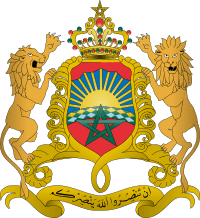Moroccan cuisine
 |
| This article is part of a series on |
| Moroccan cuisine |
|---|
| Related cuisine |
|
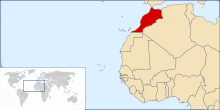
Moroccan cuisine is influenced by Morocco's interactions and exchanges with other cultures and nations over the centuries.[1] Moroccan cuisine is typically a mix of Mediterranean, Arabic, Andalusian, and most importantly, Berber cuisine with a tiny European and Subsaharian influence.
Ingredients
Morocco produces a large range of Mediterranean fruits and vegetables and even some tropical ones. Common meats include beef, goat, mutton and lamb, chicken and seafood, which serve as a base for the cuisine. Characteristic flavorings include lemon pickle, cold-pressed, unrefined olive oil and dried fruits.[2] As in Mediterranean cuisine in general, the staple ingredients include wheat, used for bread and couscous, and olive oil; the third Mediterranean staple, the grape, is eaten as a dessert, though a certain amount of wine is made in the country.[3][4]
Flavorings
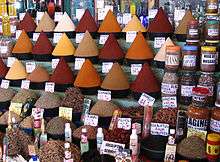
Spices are used extensively in Moroccan food. Although some spices have been imported to Morocco through the Arabs for thousands of years, many ingredients — like saffron from Talaouine, mint and olives from Meknes, and oranges and lemons from Fes — are home-grown, and are being exported internationally. Common spices include qarfa (cinnamon), kamoun (cumin), kharqoum (turmeric), skinjbir (ginger), libzar (pepper), tahmira/felfla hemra (paprika), sesame seeds, qesbour (coriander), zaafran beldi (saffron), massia (mace), qronfel (cloves), basbas (fennel), Nnafaâ (anise), elgouza (nutmeg), zaâter (oregano), felfla soudania (cayenne pepper), and Ourka sidna moussa (bay laurel). 27 spices are combined to form the "celebrated" Moroccan spice mixture ras el hanout.[5]
Common herbs in Moroccan cuisine include naanaa (mint), maadnous (parsley), quesbour (coriander), fliyo (peppermint), merdedouch (marjoram), kerouiya (caraway), and ellouiza (verbena).
Structure of meals
A typical lunch meal begins with a series of hot and cold salads, followed by a tagine or Dwaz. Bread is eaten with every meal. Often, for a formal meal, a lamb or chicken dish is next, or couscous topped with meat and vegetables on a Friday. A cup of sweet mint tea usually ends the meal. Moroccans either eat with fork, knife and spoon or with their hands using bread as a utensil depending on the dish served. The consumption of pork and alcohol is not common due to religious restrictions.[6]
Main dishes
The main Moroccan dish most people are familiar with is couscous,[7] the old national delicacy. Beef is the most commonly eaten red meat in Morocco, usually eaten in a tagine with a wide selection of vegetables. Chicken is also very commonly used in tagines, or roasted.
Lamb is also heavily consumed, and since Moroccan sheep breeds store most of their fat in their tails, Moroccan lamb does not have the pungent flavour that Western lamb and mutton have.
Since Morocco lies on two coasts, the Atlantic and the Mediterranean, Moroccan cuisine has ample seafood dishes. European pilchard is caught in large but declining quantities.[8] Other fish species include mackerel, anchovy, sardinella, and horse mackerel.[9]
Other famous Moroccan dishes are Pastilla (also spelled Basteeya or Bestilla), Tanjia and Harira, a typical heavy soup, eaten during winter to warm up and is usually served for dinner, it is typical eaten with plain bread or with dates during the month of Ramadan. Bissara is a broad bean-based soup that is also consumed during the colder months of the year.[10]
A big part of the daily meal is bread. Bread in Morocco is principally made from durum wheat semolina known as khobz. Bakeries are very common throughout Morocco and fresh bread is a staple in every city, town and village. The most common is whole grain coarse ground or white flour bread or baguettes. There are also a number of flat breads and pulled unleavened pan-fried breads.
In addition, there are dried salted meats and salted preserved meats such as kliia/khlia[11] and g'did, which are used to flavor tagines or used in "el ghraif", a folded savory Moroccan pancake.
Salads

Salads include both raw and cooked vegetables, served either hot or cold.[12] Cold salads include zaalouk, an aubergine and tomato mixture, and taktouka (a mixture of tomatoes, green peppers, garlic and spices) characteristic of the cities of Taza and Fes, in the Atlas.[12]
Desserts
Usually, seasonal fruits rather than cooked desserts are served at the close of a meal. A common dessert is kaab el ghzal ("gazelle's horns"), a pastry stuffed with almond paste and topped with sugar. Another is "Halwa chebakia", pretzel-shaped dough deep-fried, soaked in honey and sprinkled with sesame seeds; it is eaten during the month of Ramadan. Coconut fudge cakes, 'Zucre Coco', are popular also.
Drinks

The most popular drink is green tea with mint. Traditionally, making good mint tea in Morocco is considered an art form and the drinking of it with friends and family is often a daily tradition. The pouring technique is as crucial as the quality of the tea itself. Moroccan tea pots have long, curved pouring spouts and this allows the tea to be poured evenly into tiny glasses from a height. For the best taste, glasses are filled in two stages. The Moroccans traditionally like tea with bubbles, so while pouring they hold the teapot high above the glasses. Finally, the tea is accompanied with hard sugar cones or lumps.[13]
Snacks and fast food

Selling fast food in the street has long been a tradition, and the best example is Djemaa el Fna square in Marrakech. Starting in the 1980s, new snack restaurants started serving "Bocadillo" (a Spanish word for a sandwich). Though the composition of a bocadillo varies by region, it is usually a baguette filled with salad and a choice of meats, Mozarella, fish (usually tuna), or omelette.[14]
Dairy product shops locally called Mhlaba, are very prevalent all around the country. Those dairy stores generally offer all types of dairy products, juices, and local delicacies such as (Bocadillos, Msemen and Harcha).[15]
In the late 1990s, several multinational fast-food franchises opened restaurants in major cities.[16]
Moroccan food abroad
Couscous is one of the most popular North African dishes globally. Markets, stores and restaurants in Europe, especially in France and lately the United Kingdom, feature lamb tajine, bastilla, and couscous.
Paula Wolfert, prolific American author of nine cookbooks (two on Moroccan cuisine), helped enable Moroccan-Americans to enjoy their native cuisine with ease. Couscous and Other Good Food from Morocco was published in 1973 and is still in print; it was added to the James Beard Hall of Fame in 2008. Her Food of Morocco came out in 2011 and won the 2012 James Beard Award for Best International Cookbook.[17] Wolfert appeared on the Martha Stewart Show to demonstrate cooking in clay.
Raised between Fez and San Sebastian, chef Najat Kaanache has served as an unofficial culinary ambassador of Morocco, sharing Moroccan flavors and cooking techniques with many of the world's top chefs during her pilgrimage through the best restaurant kitchens of Spain, Denmark, the Netherlands and the US.[18]
Moroccan cuisine
-

Fish and seafood in Morocco
-

Eggplant turnovers, tomato rice, lentils and saffron rice
-
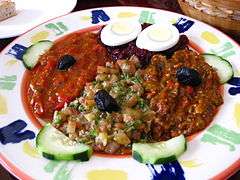
Moroccan spreads
-
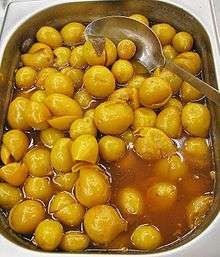
Pickled lemons called "country lemon" or "leems", a Moroccan delicacy
-

Moroccan lamb with prunes and apricots
See also
References
- ↑ "The Art of Moroccan Cuisine".
- ↑ "An Introduction to Mediterranean Cuisine". TableAgent. Retrieved 28 April 2016.
- ↑ Jancis Robinson, ed. (2006). "Morocco". Oxford Companion to Wine (3rd ed.). Oxford: Oxford University Press. pp. 453–454. ISBN 0-19-860990-6.
- ↑ Moroccan wine and Muslims, Decanter 2008-06-06
- ↑ Otal, 1999, p. 3
- ↑ Food In Morocco. Food In Every Country. Accessed April 2011.
- ↑ "Moroccan Couscous Recipe". Maroccan Kitchen Recipes (Website). Accessed April 2014.
- ↑ Lanier, B. V. (1981). The World Supply and Demand Picture for Canned Small Pelagic Fish. Food & Agriculture Org. p. 15. ISBN 978-92-5-101143-0.
- ↑ "Moroccan Sardine FAO 34". Fishery Improvement Projects. Retrieved 10 May 2016.
- ↑ Valenta, Kyle (June 23, 2016). "How to eat breakfast like a local around the world - Provided By Advertising Publications". The Seattle Times. Retrieved September 6, 2016.
- ↑ "klii"
- 1 2 Zeldes, Leah A. (Nov 11, 2009). "Eat this! Zaalouk, a cooked salad from Morocco". Dining Chicago. Chicago's Restaurant & Entertainment Guide. Retrieved Nov 12, 2009.
- ↑ Otal, 1999. p. 61
- ↑ "Bocadillo (Spanish/Moroccan Sandwich)". Maroc Mama A Fearless Guide to Food and Travel. Retrieved 10 May 2016.
- ↑ "Dairy Development in Morocco" (PDF). Food and Agriculture Organization. Retrieved 10 May 2016.
- ↑ "Fast Food in Morocco". Euromonitor International. Retrieved 10 May 2016.
- ↑ Paula Wolfert's books
- ↑ Torres, Carla. "Piripi Brings a Bit of Spain to Merrick Park: Sangria, Magic Mushrooms, and Lobster Paella (Photos)". Miami New Times. Retrieved 10 May 2016.
Further reading
Recipe books
- Connaître la cuisine marocaine, by Liliane Otal, Editions SudOuest, 1999 (in French). ISBN 978-2-879-01335-0
- Cooking at the Kasbah: Recipes from My Moroccan Kitchen, by Kitty Morse, Laurie Smith ISBN 0-8118-1503-X
- Couscous and Other Good Food from Morocco, by Paula Wolfert, Gael Greene ISBN 0-06-091396-7
- Cuisine des palais d'orient, by Alain Mordelet ISBN 2-87678-868-3
- Food of Morocco: Authentic Recipes from the North African Coast, by Fatema Hal ISBN 962-593-992-X
- Scent of Orange Blossoms: Sephardic Cuisine from Morocco, by Kitty Morse, Owen Morse ISBN 1-58008-269-6
- Traditional Moroccan Cooking: Recipes from Fez, by Madame Guinaudeau ISBN 1-897959-43-5
External links
| Wikimedia Commons has media related to Cuisine of Morocco. |

